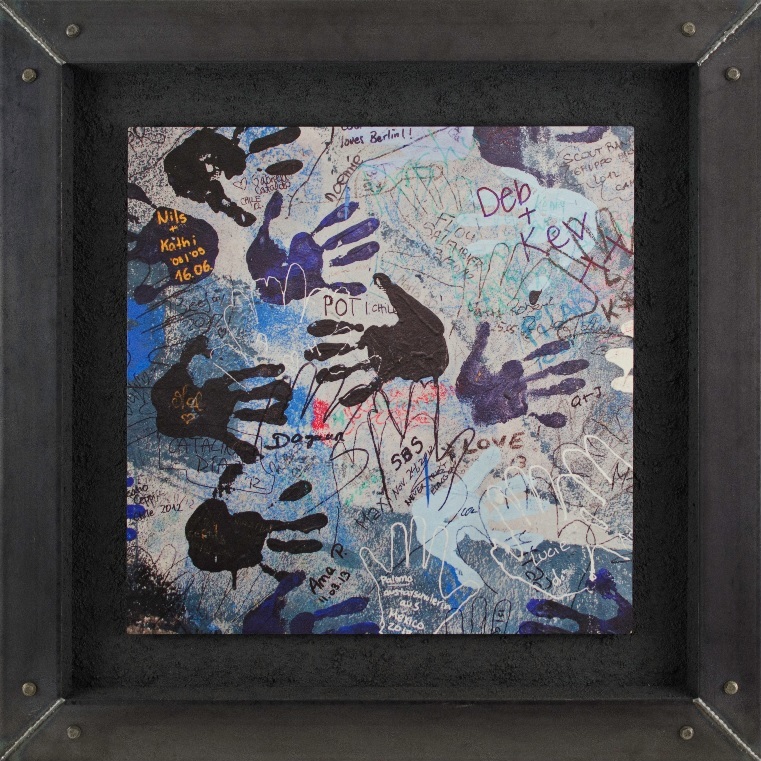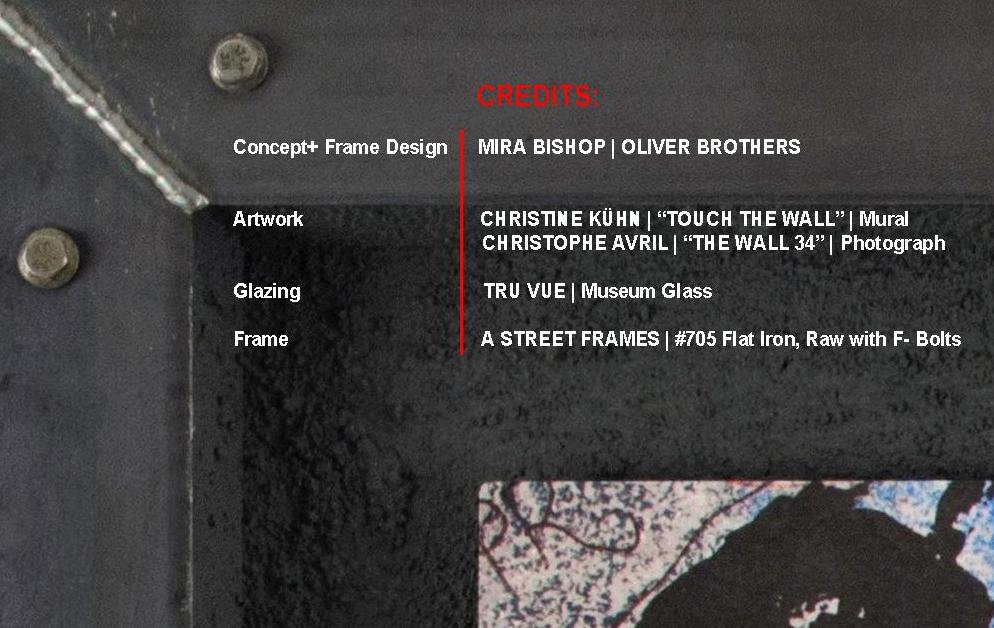Texture and Touch Commemorate the Fall of the Berlin Wall
By Mira Bishop, Oliver Brothers
The article was published on the Tru Vue’s website in April 2017 LINK :”As part of our 70th anniversary celebration at WCAF, we asked custom framers to create pieces that align breakthrough product launches from Tru Vue® with Tru Framable Moments™ that marked these times with changes in the world to highlight our company history of innovation.”

Mira Bishop of Oliver Brothers used Museum Glass® in a piece, “The Wall,” that commemorates the fall of the Berlin Wall, which took place around the time Museum Glass was introduced to the custom framing, quickly becoming the gold standard for glazing. Below she talks about her inspiration for this piece.
As I began planning my Tru Framable Moment™ for Museum Glass®, my goal was to create something that demonstrated how well this product displays texture, in addition to the UV protection and clarity it is most known for. The way Museum Glass brings out textures, colors and brightness is a benefit I think is under-represented.
Choosing the fall of the Berlin Wall, I wanted to portray this moment in a way that transformed it beyond the political. My design aesthetic was to explore the contrast between the industrial and the human.
After the Berlin Wall had fallen in November of 1989, artists were invited to create an international memorial for freedom on the wall’s east side. Located near the center of Berlin, the East Side Gallery is the largest open-air gallery at 1,316 meters that features the work of 105 artists and is the only authentic monument to the reunification of Germany.
One of those artists, Christine Kuhn, had a powerful idea. Before the fall, the Berlin Wall was inaccessible to the people of East Berlin. Armed guards patrolled the wall constantly, and people were not allowed even to touch it. In contrast to the stark surface of the East Side, the West Side was covered with graffiti. To create her mural, Kuhn stood at the wall and handed out gloves to passers-by, inviting them to leave a handprint on the wall, something she had been elated to do when first given access to the wall for her artwork.
Credits | “The Wall” | Museum Glass

One of those artists, Christine Kuhn, had a powerful idea. Before the fall, the Berlin Wall was inaccessible to the people of East Berlin. Armed guards patrolled the wall constantly, and people were not allowed even to touch it. In contrast to the stark surface of the East Side, the West Side was covered with graffiti. To create her mural, Kuhn stood at the wall and handed out gloves to passers-by, inviting them to leave a handprint on the wall, something she had been elated to do when first given access to the wall for her artwork.
As the focal point for my piece, I chose a photograph of Kuhn’s mural taken by world-renown photographer Christophe Avril. Printed on aluminum to, as Avril says, “give it more life and some eternity,” this was an ideal representation of Kuhn’s work contrasting the human experience of touch against the political and harsh image of the wall. The smooth aluminum of the photograph against the rough surface of the background emphasizes how well Museum Glass works with pieces with multiple textures.
For the frame, I wanted a heavy piece of metal with an industrial look. A Street Frames worked with me to modify their number 705 Flat Iron Raw moulding, which is welded and finished with F-bolts at the corners.
Because the wall is concrete and steel, I wanted to add texture to the background. Experimenting with cement tiles and poured concrete, I quickly realized both were too heavy. The ultimate solution was to take a standard mat board and texturize it using sand and styrofoam kernels in paint, basic house painting supplies. There were four layers applied, each requiring 24 hours to dry. The wood spacers in the piece were painted with this mixture. This created an uneven, rough surface that fit well with the industrial feel of the subject. The photograph on aluminum was float-mounted above the mat board on wood supports.
One of the biggest challenges of a piece like this is the weight for transportation and display. We created a custom crate with feet so the piece would stay vertical during transport. Inside the crate, the piece was contained in a shipping box specifically designed to hold artwork. The piece along with the crate weighed 90 pounds. To display this piece, we used a Z-Bar hanging system to distribute the weight evenly on the wall.
Working on this piece was an opportunity to be creative and do something special. It is not the first time, though, that Oliver Brothers has worked with the Berlin Wall. In 2011 Greg Bishop, co-owner and restoration expert, was asked to lead an unusual project — to restore graffiti on an actual piece of the wall that was displayed at an outdoor location in Cambridge, MA.
With the right conservation and protection, we hope that artistic expression of the Berlin Wall and its fall can be preserved for future generations to know and understand.
Please visit our page and find out more about Optium Museum Acrylic LINK